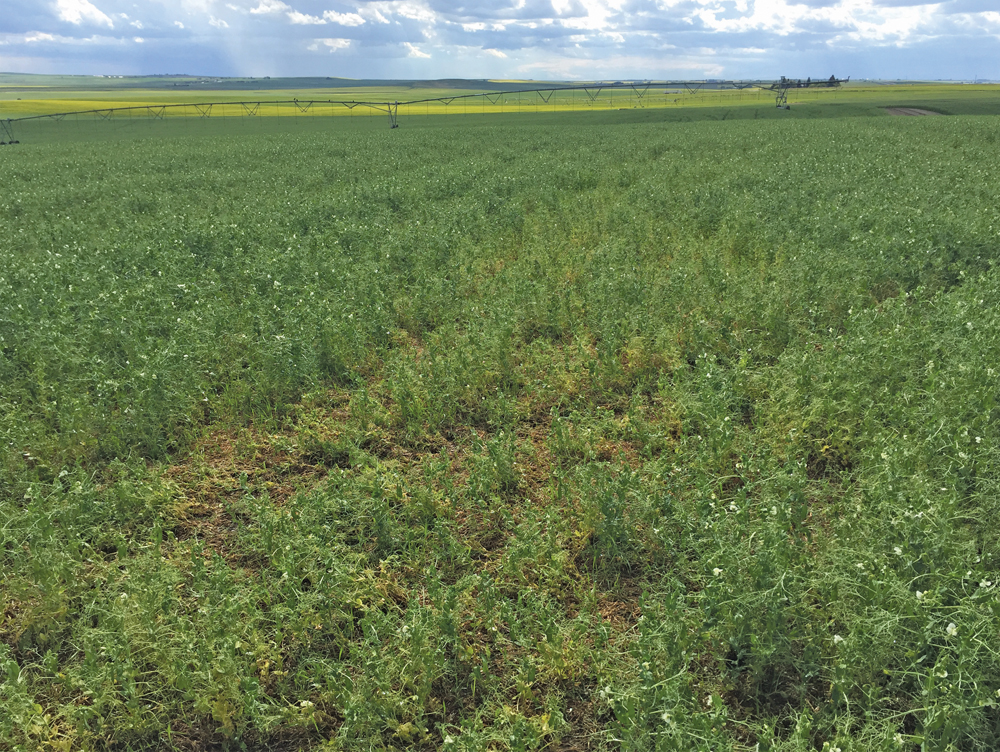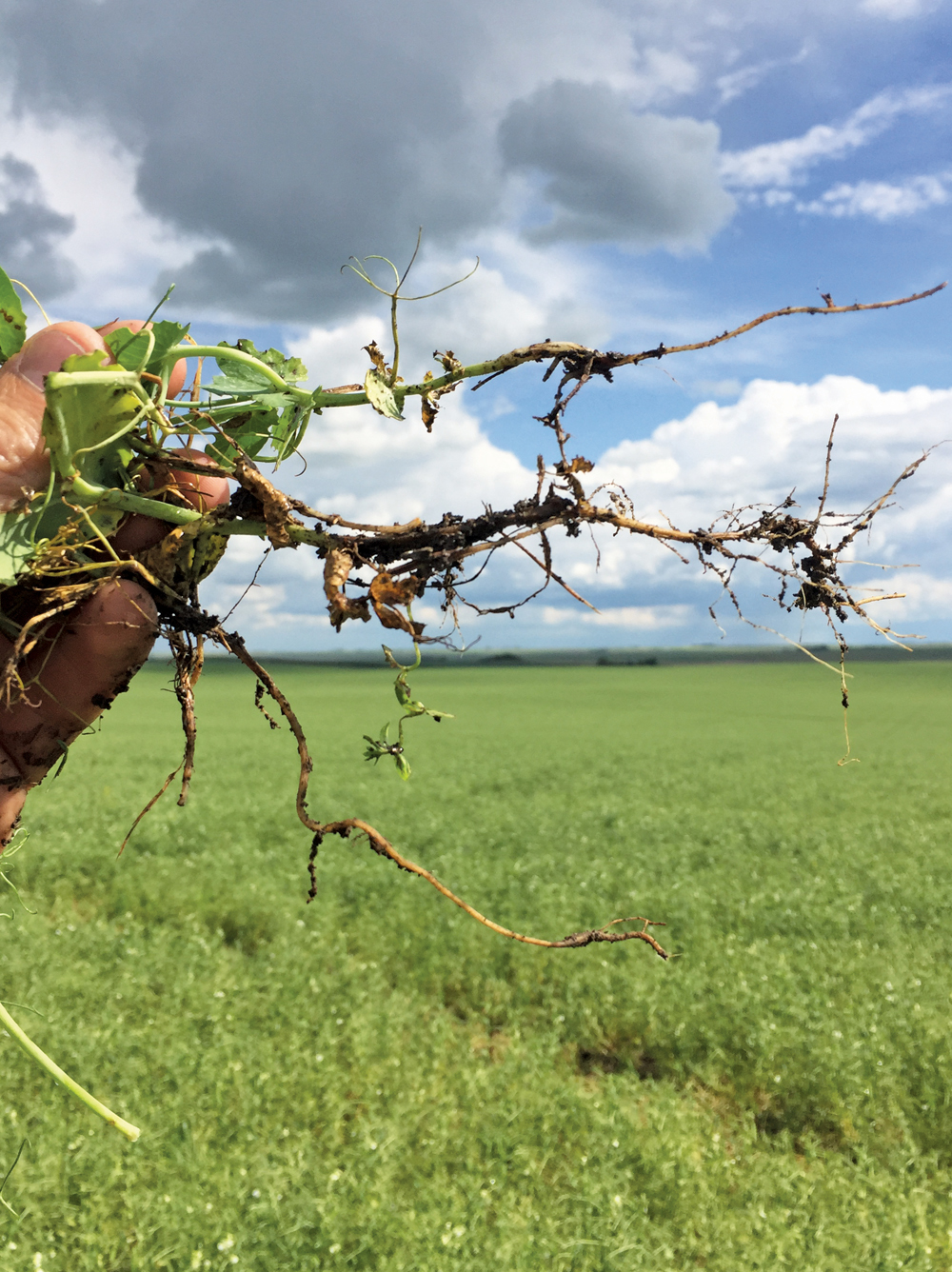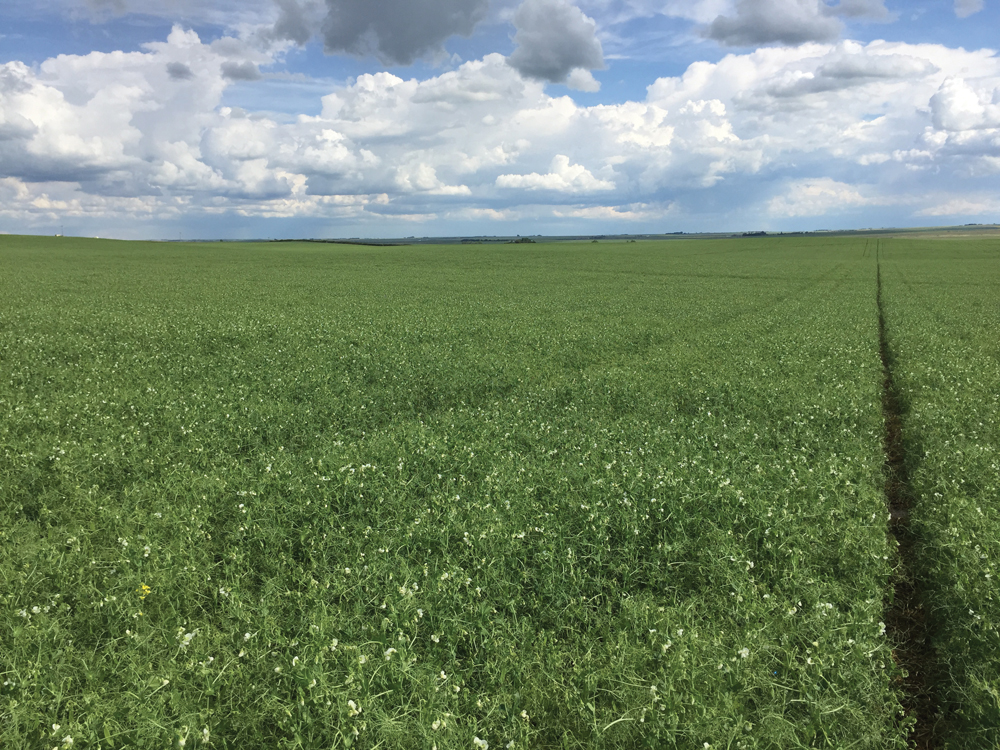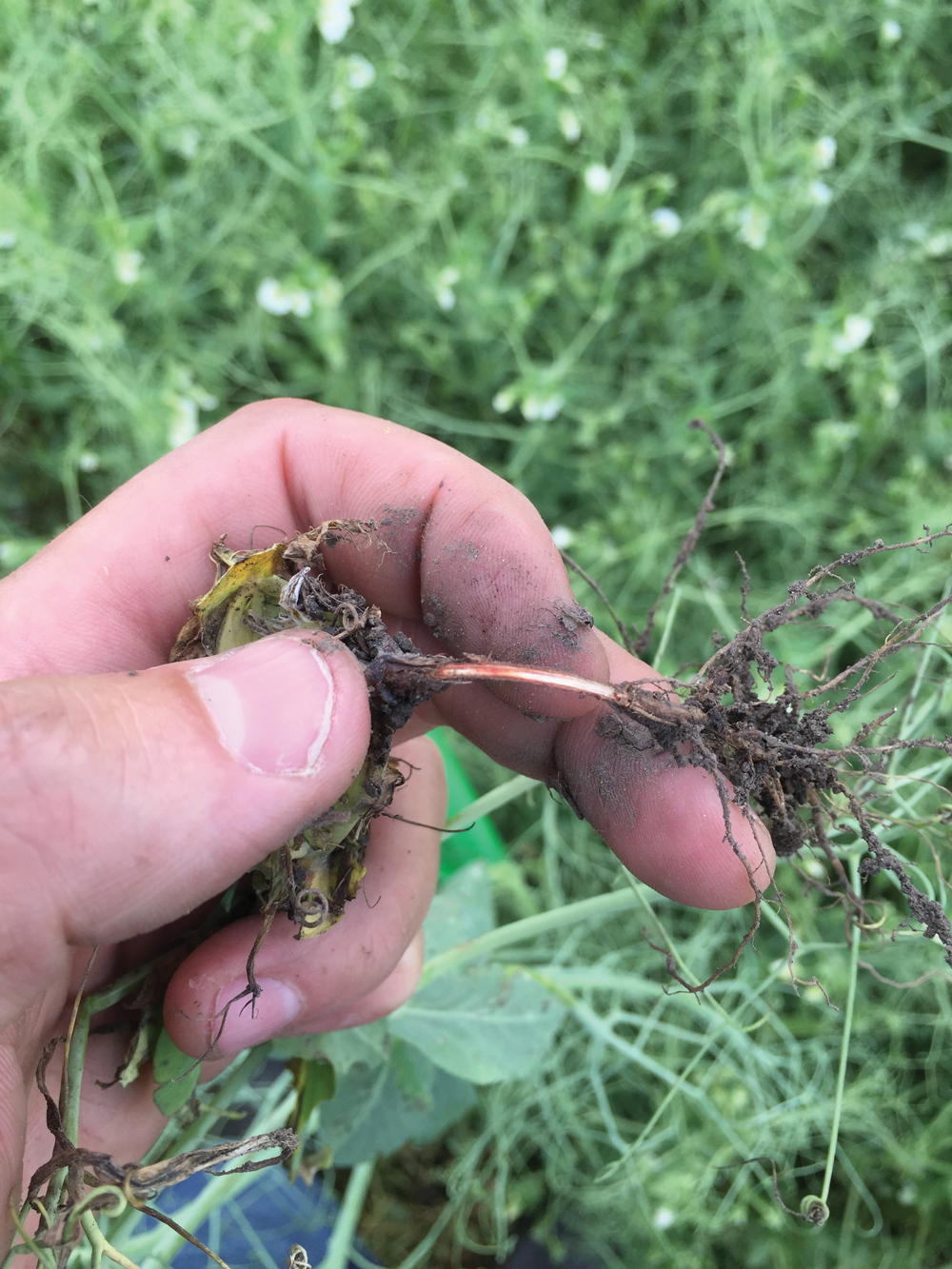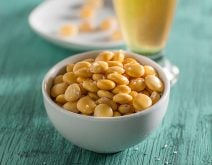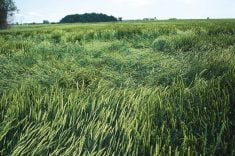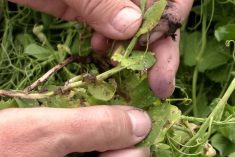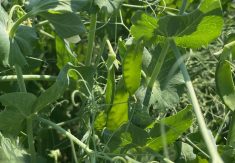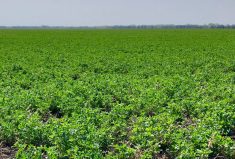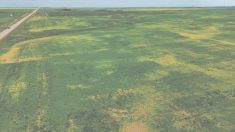
Rick grows wheat, canola, peas and malt barley west of Hussar, Alta. On July 6, last year, he placed a call to the office after he noticed his pea plants were yellowing and browning off, not just in low-lying areas, but in random patches across the field. He thought there were a few stressors at work on his crop.
“The crop may be drowning, but there’s something else going on, too — perhaps insect or disease pressure,” he told me.
When I examined Rick’s pea crop, which was in the early flowering stage, I found plants dying off in random areas of the field. Because the crop stand was thinner in the brown patches than the healthy-looking areas, I knew some plants had died earlier in the growing season.
Read Also

Claas brings 1000 Series SP forage harvesters to Canada
In mid-August, Claas unveiled its new line of Jaguar forage harvesters at an event in Visalia, California, deep in the heart of that state’s dairy region.

- I noticed some small, dark lesions on the plants’ lower leaves.
In addition, the plants’ roots were rotting. Affected roots ranged from yellowish-brown to medium brown in colour. When I examined the roots of healthy-looking plants, these were also brown and dying off.
In both affected and unaffected areas, I noticed some small, dark lesions on the plants’ lower leaves, indicating a minor mycosphaerella blight infection. The plants’ leaves were also turning yellow from the bottom of the plant upwards, and they appeared to be curling slightly downward. Also, I couldn’t find nodules on any plant roots. I knew it was a matter of time before the entire crop died.
Because there was so much going on here, it was important to examine the history of both crop and field.

- I couldn’t find nodules on any plant roots. I knew it was a matter of time before the entire crop died.
With respect to the field, no peas had been planted for at least seven years, Rick told me. There had been an issue in the past, he said, but he couldn’t remember the exact reason for the long rotation between pea crops.
That season, Rick applied a pre-seed burnoff using Group 14 and 9 herbicides for broadleaf weed and grass control. Prior to seeding, 50 pounds of anhydrous ammonia (41 pounds of actual nitrogen) was also applied, as adding nitrogen in the spring had been a routine practice on this farm for years; however, no soil tests were performed. In addition, no phosphate fertilizer was used. The soil type was loamy clay.
Rick experienced minor issues when he applied inoculant — some clumping occurred due to absorption of air moisture, so the product may not have been distributed uniformly.
The pea crop was seeded on canola stubble. Rick’s neighbour planted seed from the same seed lot and had not experienced any problems, so we knew the seed was not the issue.
The seed was treated with a Group 7 fungicide for disease control and a Group 4 insecticide for control of pests, such as pea leaf weevil.
Rick applied a herbicide with Groups 1 and 2 modes of action, to control broadleaf weeds and grasses, the first week of June. A broad-spectrum fungicide (Groups 7 and 11) was applied the last week of June. Rick noticed the brown plant patches shortly after fungicide application.
The region’s growing conditions, so far, included above-average precipitation, with regular rainfall since mid-June.
Four days prior to my visit, the crop was irrigated with two to three inches of water. This was followed by three to four inches of precipitation and a minor hail event, which didn’t affect the crop, two days prior to my arrival.

- Four days prior to my visit, the crop was irrigated with two to three inches of water.
In fact, when I scouted the field that first week of July, the soil was very wet, including the slopes. Although the moisture was excessive, the crop didn’t appear to be drowning — low-lying areas were not particularly affected and brown patches were randomly dispersed, including the slopes and hill tops.
We knew we were dealing with something that affected plant roots, such as an abiotic stress, like nutrient burn or excess moisture, or a fungal disease.
Perhaps a lack of phosphate had contributed to the weak roots, and plants were less able to take up and use the excess moisture. Or, possibly, the addition of nitrogen impaired nodulation, which, at this stage, would cause a deficiency of the nutrient, and weakened roots, overall.

- When I scraped the root’s surface, the vascular tissue was orange-red in colour.
And, we had favourable disease conditions: a warm, moist environment and a susceptible host, but which pathogen were we dealing with? I scraped the root’s surface of an affected plant. The revealed vascular tissue was orange-red in colour. That settled it for me.
Crop Advisor’s Solution: Fusarium wilt and risk management
In addition, when I examined the affected plants’ roots, I found they were rotting. The roots were yellowish-brown to medium brown in colour. When I checked the roots of healthy-looking plants, they, too, were brown and dying off. No nodules were found on any plant roots.
Although no phosphate fertilizer was used, 50 pounds of anhydrous ammonia (41 pounds of actual nitrogen) was applied prior to seeding, as adding nitrogen in the spring had been a routine practice on this farm for years. However, no soil tests were performed.
It may have been the lack of phosphate that contributed to the roots’ weakened state, as their ability to take up and use excess moisture would have been adversely affected.
Also, the addition of nitrogen could have impaired nodulation, causing this element to be deficient at that stage, and responsible for weaker roots, overall; thus, rendering the host susceptible to pathogens, but which one?
Fusarium root rot, which is caused by a variety of fusarium species, was eliminated because the roots were yellowish-brown in colour and not the characteristic black-brown of Fusarium-infected plants. Other root rot pathogens, such as aphanomyces and rhizoctonia were also ruled out because telltale symptoms, such as pinched off roots in rhizoctonia- infected plants or the development of caramel-coloured roots in aphanomyces-infected plants, were missing.
In addition to root colour and random patch distribution in the field, two symptoms that allowed me to pinpoint the responsible pathogen included the yellowing of leaves from the plant’s base upwards and, upon scraping the root’s surface, the presence of orange- red vascular tissue. Fusarium wilt, caused by fusarium oxysporum, was the disease responsible for the dying plant patches in Rick’s field.
That spring, Rick used a pea variety rated fair for fusarium wilt resistance, which he seeded on canola stubble. Going forward, I recommended Rick avoid seeding peas on canola stubble, as the pathogen has the potential to build up from the canola crop. It is best to grow peas on cereal stubble, while maintaining good control of broadleaf weeds and volunteers. At harvest, Rick’s yield was 10 to 15 bushels per acre due to the fusarium wilt infection.
I also advised Rick to continue using seed treatments with fungicides and insecticides, especially for protection against pea leaf weevil.
In addition, I recommended he apply phosphate fertilizer to his pea crops. Ideally, he should apply a blend of MicroEssentials SZ with Aspire (0-0-58-0.5B), as pulses are known to respond positively to zinc, and boron improves root growth in broadleaf crops. Bigger, stronger roots can handle the abiotic stresses of excess moisture and drought.
Using the correct source of fertilizer is important for nutrient stewardship, and is part of the 4Rs: right source, right rate, right time and right place.
In addition, field sampling and soil testing, to assess the soil’s fertility for an effective nutrient management plan, is beneficial. Those test results would allow Rick and his crop advisor to choose the best fertilizer program for the crop, thus preventing situations such as the over-application of nitrogen to peas, which can impair nodulation and weaken roots.
Root rot pathogens, such as fusarium and aphanomyces, can be found working in combination with each other. This can make it difficult to distinguish which pathogens are affecting the crop. Soil can also be tested for the presence of pathogens, such as fusarium oxysporum, aphanomyces and rhizoctonia, making disease diagnosis and management easier and more effective.
Alan Mittelstadt works for Richardson Pioneer Ltd. in Hussar, Alta.


